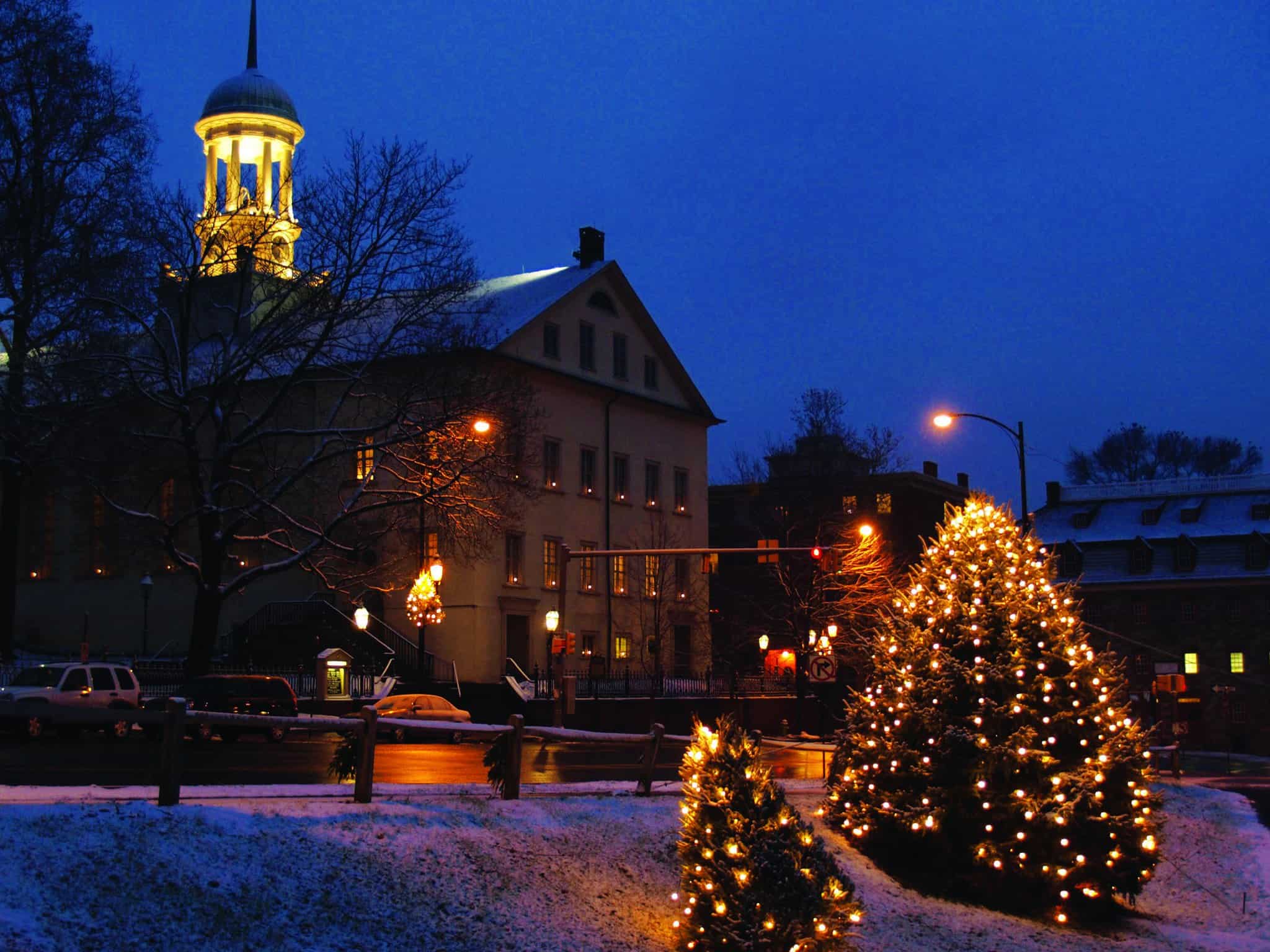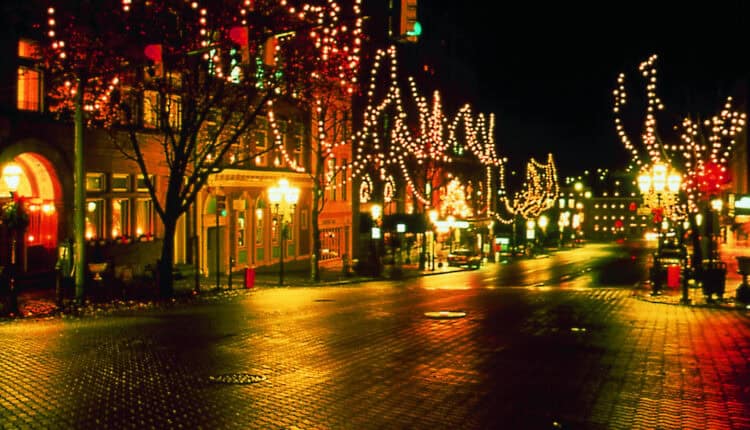Christmas in Bethlehem, PA: Explore historical Moravian holiday traditions
Moravian settlers named the Christmas City “Bethlehem” and inspired many of its enduring holiday customs.
Known as “Christmas City,” Bethlehem is a perfect place to celebrate the holidays. The city was named by Moravian missionaries who settled in the area in 1741, and today Bethlehem remains home to the largest and best-preserved Moravian settlement in North America. These early protestants brought special holiday traditions and developed new ones as their community grew. You may already recognize some of them—perhaps you even have a Moravian star on your porch—while others, like the Moravian putz, might be new to you. Read on to learn about the historical holiday traditions still celebrated in Bethlehem today—and how you can experience them too.
A brief history of the Moravian Church
The Moravian Church traces its roots to the early 1400s in Bohemia and Moravia (now the Czech Republic), when Catholic priest Jan Hus and his followers sought to reform the church. Hus was excommunicated and burned at the stake for heresy in 1415, but his teachings lived on through a group that formally organized as the Unity of the Brethren in 1457, which would become the modern-day Moravian Church.
Over the following centuries, members of the church practiced their faith in secret, and in 1722, many fled Moravia to a settlement, Herrnhut, in present-day Germany. Known as the Moravians, they became renowned for their missionary work, sending preachers around the world—including to the colony of Pennsylvania. There, they would preach to German settlers and Native Americans, setting up a central hub for all missionary work in North America.
Moravians arrived in the Bethlehem area in 1741, and on Christmas Eve of that year, they named the settlement after the birthplace of Jesus. In 1742, they established the Central Moravian Church, the oldest Moravian congregation in North America.

Get to know Moravian holiday traditions
Moravian star
A Moravian star is an iconic, multi-pointed star often used as decoration during the Christmas season. The star represents the Star of Bethlehem, which in the nativity story inspires the Three Magi to travel to Jerusalem in search of Jesus.
The first Moravian stars were created in the 1830s as part of a geometry lesson at a Moravian school in Germany. Decades later, a former student began making and selling them, and his son later opened a factory to manufacture them. That factory—Herrnhuter Sterne—is still producing them today!
The tradition spread throughout Moravian communities, and the stars are now a common and beloved part of Bethlehem’s holiday scenery. They’re especially popular at Bethlehem’s famous Christkindlmarkt.

Putz
A “putz” is a Moravian nativity scene that tells the story of Jesus’ birth with elaborate miniature figurines. The construction of a putz was a common Moravian tradition, so much so that “going putzing” involved visiting your friends to admire their putzes.
In Bethlehem, the Central Moravian Church has displayed a putz for the community each holiday season since 1937. The putz opens the day after Thanksgiving and can be viewed through December 31.
Christmas Eve Lovefeast
A lovefeast is a Moravian tradition that combines a worship service with singing, lit beeswax candles, and a simple, shared meal, like sweetened buns and coffee or juice. It’s not uniquely Moravian—other Christian traditions also hold lovefeasts—but the tradition is widely loved by Moravians around the world.
Lovefeasts can be held year-round, but they are particularly popular on Christmas Eve, since there’s so much to celebrate.
The Central Moravian Church in Bethlehem is holding a Children’s Lovefeast Service on Christmas Eve, a holiday service designed for children and families. Parishioners will pass out handcrafted beeswax candles to light, everyone will sing Christmas songs, and the Children’s Sunday School will share a dramatic telling of the Christmas Story.
Other Christmas candlelight services at the church will also feature the traditional Moravian beeswax candle.

Christmas trees
We think you might be familiar with this tradition! While Moravians didn’t invent the Christmas tree, one might say they were “early adopters.” Initially, Moravians used wooden pyramids, decorated with greenery, candles, fruit, and a nativity scene (putz) as their version of a Christmas tree. Some were small enough to decorate a tabletop, while others were as large as full-sized trees themselves. The first recorded use of such a “Christmas tree” in Bethlehem dates to 1747.
As evergreen trees became more popular among German immigrants, Moravians began decorating them as well. Indeed, the first known depiction of a Christmas tree in the U.S. was sketched circa 1812 and shows a family celebrating in the Moravian tradition.
Moravians are also credited with being the first to add candles to the boughs—a custom that has since faded with the advent of (much safer) electric lighting.
You can explore beautifully decorated Christmas trees in Historic Bethlehem this holiday season by purchasing tickets to the 2025 Trees of Historic Bethlehem showcase. The exhibit features more than 20 trees displayed across three different historic sites. Tickets to the showcase include admission to the Kemerer Museum of Decorative Arts, the Moravian Museum of Bethlehem, and Single Sisters’ House (home of a Moravian putz).

Experience Moravian culture in and around Bethlehem
Historic Moravian Bethlehem National Historic Landmark District
Just last year, the historic district’s Moravian Church settlements, together with important Moravian sites in Europe, were designated as a UNESCO World Heritage Site.
Visitors can embark on a 90-minute guided tour of Bethlehem’s World Heritage Site on Saturday afternoons for $25. The tour may not have a holiday theme, but you can be sure that many of the sites will be traditionally decorated. One site of note is the Moravian Museum of Bethlehem, located in the 1741 Gemeinhaus—the oldest building in the city.
Nazareth
The small town of Nazareth, roughly 20 minutes north of Bethlehem, is home to the Moravian Historical Society. The town is hosting Christmas in Nazareth on Dec. 13, during which the Moravian Historical Society will host a holiday market with local artisans, walking tours of Historic Nazareth, and its own putz display.



